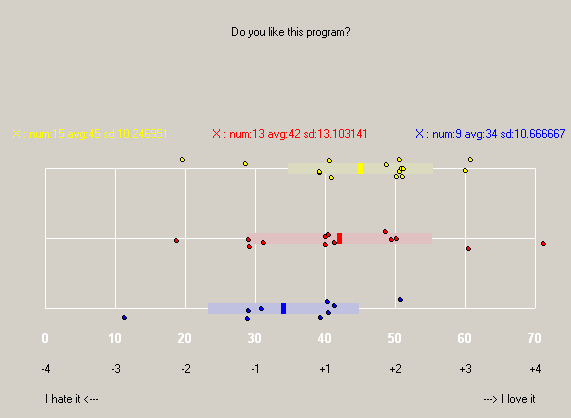|
Effects of Subliminal Conditioning
on Computer Program Users
by Hyemin Chung
Participants
Total : 42
8 females, 34 males
Ages : 20~35 years old
Control Group
Total : 16
3 females, 13 males
Positive Group
Total : 15
2 females, 13 males
Negative Group
Total : 11
3 females, 8 males
Results
The graphs are about the answers of participants.
Yellow means the control group, red means the positive group, and blue means the negative group.
Each circle means one participant, colored squares mean average, and bars with light colors express standard deviation.
Users' Initial Emotional Status

Before the experiment, I asked to users how they were feeling.
Basically, users in the control group were in better mood than other groups,
and it could affect the experiment results.
Thus, we have to concern this factor when we analyze the results.
Users' Recognition of Subliminal Conditionings

Some participants answered that they recognized something was flashing between the scenes,
but most participants couldn't recognize them.

Five participants answered that they could figure out what was the flashing image (subliminal conditioning).
However, 40% of them were in the control group which did not contain any subliminal conditioning image.
Additionally, I asked to two other participants, who answered that they saw the subliminal conditioning images,
what they saw, and they couldn't answer. I did not check the rest one participant who said "I recognized the subliminal image".
Thus, I assumed that even though some people answered that they recognized the image,
it might be generated from their imagination when they were asked if they saw something, and thus not important.
All the results below are analyzed and graphed after one maximum value and one minimum value are removed.
Effects on the Users' Responses to the Program






In most cases, the participants of the control group answered most positively, while the participants of the negative group answered most negatively. The positive group is in the middle of them.
Actually, it is a little different from what I expected. According to my hypothesis, that positive subliminal conditioning might cause positive responses,
the positive group should respond most positively.
The reason of this result could be thought as
1. The difference in initial emotional status affected the result.
2. The existence of subliminal conditioning itself caused negative effects because of increased cognitive load.
3. Negative effects are far more stronger than positive effects in subliminal conditioning.
4. The subliminal conditioning image used for the positive group was not positive enough.
However, we can see that participants in the positive group are most willing to participate the experiment again. Thus, it might be possible that positive subliminal conditioning can affect on the good will of the users.
Effects on the Users' Mood and Arousal

This question was asked after the experiment.
At a glance, it seems like the control group were affected positively while other groups were little affected or negatively affected. However, in fact, all of the three groups were little affected when comparing with the initial emotional status, which can be seen in the top of this page.

We can hardly see the difference between the groups.
Unlike the responses to the programs, users' emotional status such as valence and arousal seems not strongly affected by subliminal conditioning.
Thus, it is interesting that even users did not recognize their emotional changes, their responses were changed. This phenomenon has been reported in other research such as [Winkielman, 2005].
However, because I asked about the programs before I asked about the participants' emotional status, it could neutralize the users' emotional responses by the same way I removed the external effects by the pre-study questionnaire.
Cognitive Load Problems
Most of the questions do not have correct or incorrect answers.
Thus, users can choose any answers they wanted to.
However, there were four questions which have correct and incorrect answers.
Below are the answers of the four questions with correct and incorrect answers.

The correct answer of this question is 30.

The correct answer of this question is 14th.

The correct answer of this question is 1st.

The correct answer of this question is 28th.
Although the difference is slight, the correct answer ratio is highest mostly in the control group, and the average value is closest to the correct answer mostly in the control group.
Maybe we can doubt that because conditioning groups saw more pictures including subliminal images, they have to answer wrongly - they have to answer larger values than correct answers.
If that was true, the subliminal conditioning groups might answer more pictures than the control group because, actually, they saw more images including subliminal conditioning images.
However, the conditioning groups answered less pictures than the control group.
Thus, the reason of higher ratio of wrong answer in conditioning groups are not caused from the number of pictures they saw.
The reason can be guessed like
1. Because subliminal conditioning images increased the cognitive load of the brains, the brains are distracted and tired.
2. Because conditioning groups less liked the program than the control group.
It could be the result of increased cognitive load caused from the subliminal conditioning images. However, there is also possibility of coincidence because the number of subjects is not enough big. It is also possible that, accidentally, there could be more smart people in the control group.
|
|